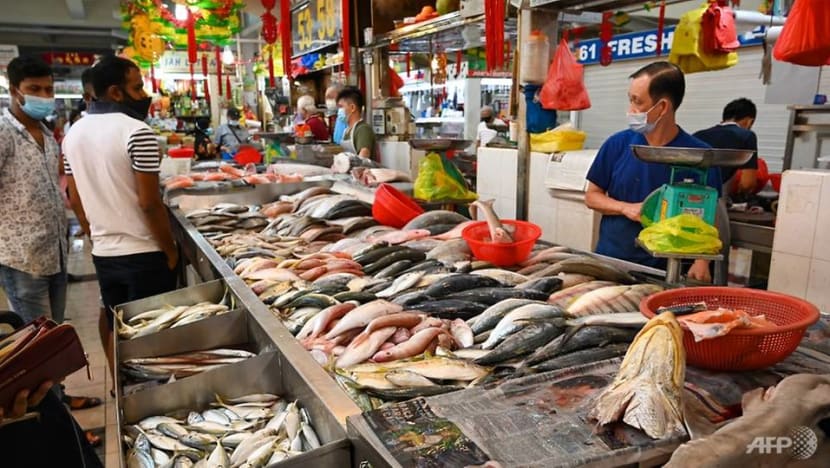‘A lot of confusion’ for stallholders and fishmongers as stalls remain closed with COVID-19 testing under way

People shop for fish at a wet market in Singapore on Jan 6, 2021. (Photo: AFP/Roslan Rahman)
SINGAPORE: Fish stall owners and suppliers who had to cease operations after the emergence of the COVID-19 cluster at Jurong Fishery Port are finding themselves in limbo, with some “confused” about whether they can reopen for business.
This comes after fresh fish and seafood stallholders at markets managed by the National Environment Agency (NEA) or its appointed operators were ordered to stop operations on Sunday (Jul 18).
READ: Fresh fish and seafood stalls ordered to stop operating; stallholders to undergo COVID-19 test
They were also required to undergo a COVID-19 polymerase chain reaction (PCR) test and to self-isolate and not leave their homes until they were confirmed to have tested negative for the virus.
As of Wednesday, there are 454 cases linked to the growing cluster at Jurong Fishery Port - the largest active cluster in Singapore.
COVID-19 cases have been detected in at least 35 markets and food centres linked to the growing Jurong Fishery Port cluster, said the Ministry of Health (MOH) on Tuesday.
Several stallholders told CNA that after testing negative on Monday or Tuesday, they have yet to receive updates from NEA or MOH about whether they can reopen their stalls.
“I have called up NEA, and was told (I) have to wait until further notice,” said Mr Koh Keng Meng on Wednesday.
Mr Koh owns Three Kings Hand Slam Fishballs at Serangoon Garden Market and Food Centre and also manages three other stalls selling fresh fish and seafood.
He tested negative for COVID-19 on Tuesday after closing his stalls on Sunday morning.
Mr Koh said that there is “a lot of confusion” among stallholders about whether they can reopen.
“For my fellow fishmongers who are 60 or 70 years old, they don’t know anything that’s happening, it’s all different news. (It’s all) hearsay - you tell me, I tell you. Nothing’s confirmed.”
The 48-year-old said he had to give away the seafood he had prepared to sell on Sunday, but he is more concerned about his next few steps.
“We have to resume business as soon as possible,” he added.
In a joint statement on Sunday, MOH and NEA had said stallholders who receive a negative PCR test result can resume business immediately.
Fresh fish and seafood stallholders will be issued with self-test antigen rapid test kits and will need to test themselves a week from their last exposure to a positive case, said MOH and NEA in the joint statement.
They will also need to undergo another PCR test about two weeks from their date of last known exposure.
CLOSURE ON SECOND DAY OF OPERATIONS
For Mr Bryan Ang, the owner of The 11th Street Raw Cuts, Sunday was supposed to be second day of operations for his newly opened fresh seafood stall at Tampines Round Market.
But the closure meant that he was left with more than 300kg worth of fresh red prawns and 160kg worth of crabs unsold.
The 29-year-old had just started his brick-and-mortar stall after operating online for a few years.
“Tuesday was Hari Raya, and on Saturday we heard that Jurong Fishery Port would be closed for two weeks, so many of us actually started to prepare more stocks to sell on the coming weekend,” adding that he had ordered double his usual amount of seafood.
READ: TraceTogether check-in to be mandatory at all wet markets and hawker centres in Singapore
When NEA officers made their rounds in the early hours of Sunday morning, Mr Ang’s wife had just finished opening the stall as he was isolating himself at home while waiting for the COVID-19 test results.
“They came down and told us to keep everything and close the stall within 10 minutes. So we were stuck with a lot of stocks, and (for) seafood there’s nothing that we can keep for a few days. Nobody will purchase seafood to keep, everybody will purchase it fresh,” he said.
The couple gave away 120kg of red prawns for free, and threw most of the crabs away, resulting in losses of between S$6,000 and S$8,000, Mr Ang told CNA.
“All our seafood are high cost, it really affects us a lot. Because of the fishery port closure, we will be out of business for two weeks,” he added.
Some of his fellow fishmongers and stallholders in the market who are above 70 years old also had trouble understanding what was going on, said Mr Ang.
“(NEA) indicated that fishmongers are supposed to self-isolate, they did not indicate that the stall has to cease operations,” he said, referring to NEA’s first announcement of the closure of Jurong Fishery Port on Saturday night.
“Of course, many stallholders were not happy about it. Especially those old aunties and uncles … They said they don’t even understand the English messages (they received from the authorities). How are they supposed to understand all of this?” said Mr Ang.
READ: KTV and Jurong Fishery Port COVID-19 clusters are 'linked': Ong Ye Kung
FISH SUPPLY CONTINUES: SUPERMARKETS
Following the closure of Jurong Fishery Port, supermarkets in Singapore said they saw increased demand for fresh fish across their outlets.
“Following the news yesterday, we immediately contacted our suppliers to explore alternatives and ramp up existing supply,” said an NTUC FairPrice spokesperson, adding that frozen seafood options are also available.
“Additional resources were quickly put in place to receive the fresh seafood as well as manage the increase in demand over the next two weeks.”
Demand in FairPrice stores “remains elevated”, said the spokesperson, encouraging customers to “only buy what they need”.
A HAO Mart representative said the supermarket chain is looking at alternative supply routes, and has existing stocks for frozen fish and seafood.
While the closure of Jurong Fishery Port “may pose a slight inconvenience” to retailers, the supermarket is able to adapt after its experience with the COVID-19 pandemic over the past year, said the representative.
“We have seen a slight demand for fresh fishes and seafood, but not excessive,” the HAO Mart representative added.
Dairy Farm Group, which operates the Giant and Cold Storage outlets here, said the closure of the fishery port will impact its seafood supplies over the next two weeks. It is currently working with its suppliers to increase existing supply, said a spokesperson.
“We remain committed to keeping the prices of our seafood stable as we understand that these continue to be challenging times for everyone,” the spokesperson said, adding that the group did not observe a surge in store traffic.
“Customers can rest assured that we have sufficient stocks to cater to the expected demand. We will continue to have fresh and frozen seafood in our stores for purchase. We will also not be placing a purchase limit, but encourage our customers to only purchase what they need.”
For Prime Supermarket, a large part of its seafood is directly supplied by its own sea farm in Pulau Tekong.
While the closure of the fishery port will affect some of its external supply of seafood, the disruption will be “minimal”, said a company spokesperson.
“We have seen an increase of purchase quantity from customers since the announcement of closure. We are well prepared for the demand with the support and supply from our sea farm,” the spokesperson added.
The spike in demand for fresh fish and seafood at its outlets was “noticeable but sporadic”, as there is a wide range of seafood products available, said the spokesperson.
READ: COVID-19 cases detected among fishmongers in at least 11 markets
FISH AND SEAFOOD SUPPLIERS
Importers and suppliers operating out of Senoko Fishery Port have also been affected by the closure of the Jurong Fishery Port and wet market stalls.
Since most wet market stalls and fishmongers are closed, suppliers are also making fewer sales, said chairman of the Punggol Fish Merchant Association and CEO of importer Seafood Element Daniel Pe.
Hawkers and fishmongers typically make up the bulk of the purchases for most suppliers, he said.
“If they cannot sell, then who’s buying from us? No one is buying from us, other than those of us who supply to restaurants and hotels. That’s a different story,” he told CNA.
READ: Jurong Fishery Port cluster: No evidence of COVID-19 transmission through contaminated fish, says MOH
For most suppliers that operate out of Jurong Fishery Port and have to stop operations for two weeks, business is “100 per cent affected”, said sales manager of FishMart SG Jackson Lim.
Two weeks of closure would cost the company about S$10,000 to S$20,000 worth of sales, said Mr Lim.
“What we’re worried about is the port, we’re unable to have 100 per cent clearance of COVID-19 (cases),” he told CNA, adding that many people, including fishmongers, gather at the port at a time.
“I really hope that (after) two weeks, when it reopens … SFA (Singapore Food Agency) will control the port very strictly, and hope that everyone can be COVID-free,” said Mr Lim.
Mr Lim said the port should then be closed to the public and opened only to fishmongers and licensed business owners who use it.
“Because we won’t know if the visitors who are not wholesalers or (working in the) wet markets - will they bring COVID in again?
“The port is this big and (is a) very centralised place. People come, and (if there is a case), it will spread like fire to the community.”
BOOKMARK THIS: Our comprehensive coverage of the coronavirus outbreak and its developments
Download our app or subscribe to our Telegram channel for the latest updates on the coronavirus outbreak: https://cna.asia/telegram












